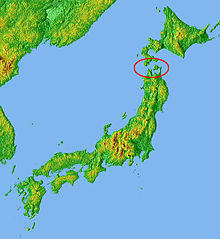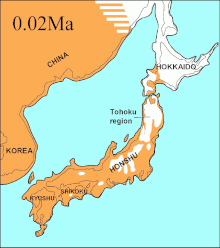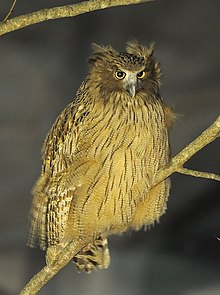20:
165:. As to when these land bridges existed, scientists do not agree. It may have been between 26,000 and 18,000 years ago, it may have been later than that. Sakhalin, the island just north of Japan, and Hokkaido may even have been connected to the mainland as recently as 10,000 years ago or less. Apart from these former land bridges, there are more factors that play a role in why there is a difference in the fauna north and south of the line:
195:
118:
453:
are excluded from this table, even though their habitat is clearly south of
Blakiston's Line, as other factors account for their distribution. Besides animal species that can only be found either north or south of Blakiston's Line, there are very many that can be found at either side of the line, in
542:
remarked: "Our knowledge of
Japanese ornithology is only fragmentary" The years after his stay in Japan, Blakiston made publications on birds in Japan in general and on water birds of Japan in particular. Bird species like
622:
Effects of climate, distance, and a geographic barrier on ectomycorrhizal fugal communities in Japan: A comparison across
Blakiston's Line by Yumiko Miyamoto, Maki Narimatsu and Kazuhide Nara, Hokkaido University January
596:
871:
531:
There has been speculation about why
Blakiston was the person who discovered this faunal boundary line and no one before him had done so. Andrew Davis, who has been a professor at
555:
Blakiston have been named after him. In
Hakodate, Blakiston made a large collection of birds, which is currently located at the museum of Hakodate. The distributions of many
650:
EFFECTS OF WAVE, TIDAL CURRENT AND OCEAN CURRENT COEXISTENCE ON THE WAVE AND CURRENT PREDICTIONS IN THE TSUGARU STRAIT, Ayumi
Saruwatari, Yoshihiro Yoneko and Yu Tajima
516:
974:
520:
504:
512:
816:
770:
508:
872:"A Line in Birds:Thomas W Blakiston's contribution to Ornithology and Biogeography in Early-Meiji Japan by Andrew Davis - Japan Society of the UK"
672:
181:
The influence of the human population in the north is different from that in the south, the north is more sparsely populated and there are more
904:
A Catalogue of the Birds of Japan by T. Blakiston and H. Pryer, Ibis
International Journey of Avian Science, Fourth Series, No. VII. July 1878
659:
Conlon, Dennis
Michael, "Dynamics of Flow in the Region of the Tsugaru Strait." (1980). LSU Historical Dissertations and Theses. 3557.
484:
137:
The difference in the fauna can probably be attributed to land bridges that may have existed in the past. Whilst
Hokkaido may have had
86:
63:. Certain animal species can only be found north of Blakiston's Line, while certain other species can only be found south of it.
473:
On the contrary to major hypothesis that terrestrial animals couldn't move across
Blakiston's Line, excavations of fossils of
1019:
950:
833:
538:
Blakiston spent much time researching bird species in Japan. At that time, Japanese ornithology was at its infancy. In 1886
465:
It has also been studied whether or not this biogeographic boundary applies to far smaller organisms like soil microbes.
928:
951:"Monument of Blakiston | Must-see-japan Hakodate-shi (Japanese sightseeing promotion association) of the whole country"
632:
A new timeframe for the diversification of Japan's mammals by Bailey D. McKay, Blackwell Publishing Ltd, Hoboken 2011
934:
923:
559:
species observe the Blakiston line, since many birds do not cross even the shortest stretches of open ocean water.
535:
for four years, argued that this may have been because of his unusual position in Japanese society as a European.
895:
Review of Japanese Birds in Proceedings of United States National Museum by Leonhard Stejneger, Washington 1886.
221:
do not even live north of Blakiston's Line. The following table gives some examples of animal species involved:
260:
982:
458:, a breed of small Japanese beef cattle that is distributed in northern Honshu and also in Hokkaido, and the
854:
495:
from Honshū indicate a new assumption that terrestrial animals could have crossed the strait periodically.
841:
1024:
1014:
913:
Water-birds of Japan in Proceedings of United States National Museum by T.W. Blakiston, Washington 1885
680:
927:
205:
Besides birds, animals that are of different origins north and south of the Blakiston Line include
102:
544:
430:
198:
641:
Dobson, M. (1994), Patterns of distribution in Japanese land mammals. Mammal Review, 24: 91–111.
475:
719:
1009:
810:
764:
582:
Collection Writings of Sir Hugh Cortazzi, Volume II, Sir Hugh Cortazzi, Routledge, Oxon, 2000
660:
503:
Apart from Blakiston's Line, other faunal boundary lines have been proposed for Japan, like
829:
8:
837:
532:
408:
374:
251:
539:
455:
240:
338:
333:
175:
Currents in the Tsugaru Strait are strong, tidal currents coincide with ocean currents
798:
752:
492:
399:
256:
235:
107:
Zoological Indications of Ancient Connection of the Japan islands with the Continent
790:
356:
162:
112:
66:
459:
392:
347:
314:
290:
563:
450:
412:
365:
285:
90:
743:奥村潔, 石田克, 樽野博幸, 河村善也 (2016). "岐阜県熊石洞産の後期更新世のヤベオオツノジカとヘラジカの化石(その1)角・頭骨・下顎骨・歯".
709:
The Wildlife in Japan, Ministry of the Environment of Japan, Tokyo, March 2015
562:
For his discovery of Blakiston's Line, a monument was erected in his honor on
19:
1003:
802:
756:
421:
383:
275:
267:
146:
468:
302:
439:
247:
94:
60:
24:
194:
69:, who lived in Japan from 1861 to 1884 and who spent much of that time in
297:
182:
138:
130:
326:
321:
178:
The climate in the north is generally far colder than that in the south.
74:
52:
40:
794:
172:
The narrowest part of the Tsugaru Strait is 12.1 miles (19.5 km).
59:, south of it. It can be compared with faunal boundary lines like the
778:
515:(Soya line): for reptiles, amphibians and freshwater invertebrates,
82:
56:
214:
142:
122:
117:
70:
454:
part because of human involvement. Examples of the latter are the
169:
The Tsugaru Strait is relatively deep, the maximum depth is 449 m.
154:
113:
Explanations and hypotheses on the existence of Blakiston's Line
720:"Hokkaido Island In Japan Is Home To 7 Incredibly Cute Animals"
218:
158:
150:
126:
44:
189:
488:
309:
206:
121:
Japanese archipelago, possibly 10,000–20,000 years ago, with
48:
556:
210:
78:
73:, Hokkaido, was the first person to notice that animals in
462:, which was introduced to Hokkaido by human intervention.
661:
https://digitalcommons.lsu.edu/gradschool_disstheses/3557
469:
Possible trans-Blakiston's Line movements by land animals
161:, may have been connected to the Asian continent via the
700:
Lonely Planet Japan by Rebecca Milner et al. 15 ed. 2017
498:
133:; the thin black line indicates present-day shorelines.
93:
between the two islands was therefore established as a
776:
742:
77:, Japan's northern island, were related to northern
43:
boundary line drawn between two of the four largest
860:. Ministry of the Environment Government of Japan.
511:): for mammals, reptiles, amphibians and spiders,
1001:
16:Line separating the fauna of Hokkaidō and Honshū
526:
590:
588:
815:: CS1 maint: multiple names: authors list (
769:: CS1 maint: multiple names: authors list (
618:
616:
975:"Mount Hakodate Observatory - Zipang Guide"
779:"岐阜県熊石洞産の後期更新世のヤベオオツノジカとヘラジカの化石(その2)体幹骨・肢骨"
190:Species north and south of Blakiston's Line
23:The Tsugaru Strait which forms the natural
955:www.nihon-kankou.or.jp.e.wp.hp.transer.com
585:
101:. This finding was first published to the
922:
613:
736:
193:
116:
85:to the south were related to those from
18:
1002:
449:Species that can only be found on the
105:in a paper of 14 February 1883, named
834:National Museum of Nature and Science
499:Other faunal boundary lines in Japan
13:
594:
149:, the other islands of Japan like
14:
1036:
924:Blakiston, Herbert Edward Douglas
939:. Vol. 1. pp. 214–215.
935:Dictionary of National Biography
929:"Blakiston, Thomas Wright"
673:"CHAPTER ONE – BLAKISTON'S LINE"
597:"The Blakiston Line in Hokkaidō"
201:was named after Thomas Blakiston
967:
943:
916:
907:
898:
889:
864:
847:
823:
712:
703:
694:
665:
653:
644:
635:
626:
576:
261:Japanese giant flying squirrel
97:boundary, and became known as
1:
777:樽野博幸, 河村善也, 石田克, 奧村潔 (2017).
569:
1020:1883 establishments in Japan
679:. 2009-12-10. Archived from
527:The role of Thomas Blakiston
322:East Siberian (or Ezo) stoat
27:boundary of Blakiston's Line
7:
10:
1041:
553:Regulus regulus japonensis
230:South of Blakiston's Line
227:North of Blakiston's Line
141:to the north of Asia, via
81:species, whereas those on
103:Asiatic Society of Japan
876:Japan Society of the UK
476:Palaeoloxodon naumanni
202:
134:
28:
842:本州にかつて生息していたヒグマの起源の解明
487:) from Hokkaidō, and
339:Japanese least weasel
197:
120:
22:
830:Yamanashi University
751:. 大阪市立自然史博物館: 1–82.
545:Blakiston's Fish Owl
431:Blakiston's fish owl
199:Blakiston's fish owl
185:living in the north.
838:Yamagata University
533:Hokkaido University
481:Sinomegaceros yabei
409:Siberian salamander
375:Japanese shrew mole
334:Common least weasel
252:Ezo flying squirrel
1025:1883 introductions
1015:Geography of Japan
540:Leonhard Stejneger
456:Japanese Shorthorn
241:Asiatic black bear
203:
135:
29:
855:"Nature in Japan"
795:10.20643/00001228
677:TravelsWithThomas
493:Ussuri brown bear
447:
446:
400:Siberian chipmunk
280:
272:
257:Japanese squirrel
236:Ussuri brown bear
55:in the north and
1032:
994:
993:
991:
990:
981:. Archived from
971:
965:
964:
962:
961:
947:
941:
940:
937:(1st supplement)
931:
920:
914:
911:
905:
902:
896:
893:
887:
886:
884:
883:
868:
862:
861:
859:
851:
845:
827:
821:
820:
814:
806:
774:
768:
760:
740:
734:
733:
731:
730:
716:
710:
707:
701:
698:
692:
691:
689:
688:
669:
663:
657:
651:
648:
642:
639:
633:
630:
624:
620:
611:
610:
608:
607:
595:Planet, Lonely.
592:
583:
580:
517:Hachisuka's line
357:Japanese macaque
291:Honshu sika deer
278:
270:
224:
223:
163:Korean Peninsula
99:Blakiston's Line
67:Thomas Blakiston
37:Blakiston's Line
1040:
1039:
1035:
1034:
1033:
1031:
1030:
1029:
1000:
999:
998:
997:
988:
986:
973:
972:
968:
959:
957:
949:
948:
944:
921:
917:
912:
908:
903:
899:
894:
890:
881:
879:
870:
869:
865:
857:
853:
852:
848:
828:
824:
808:
807:
775:
762:
761:
741:
737:
728:
726:
718:
717:
713:
708:
704:
699:
695:
686:
684:
671:
670:
666:
658:
654:
649:
645:
640:
636:
631:
627:
621:
614:
605:
603:
593:
586:
581:
577:
572:
549:Bubo blakistoni
529:
501:
471:
460:Japanese weasel
411:
393:Japanese badger
348:Japanese weasel
315:Japanese marten
259:
250:
192:
115:
95:zoogeographical
25:zoogeographical
17:
12:
11:
5:
1038:
1028:
1027:
1022:
1017:
1012:
996:
995:
966:
942:
915:
906:
897:
888:
863:
846:
822:
789:(71): 17–142.
783:大阪市立自然史博物館研究報告
745:大阪市立自然史博物館研究報告
735:
711:
702:
693:
664:
652:
643:
634:
625:
612:
584:
574:
573:
571:
568:
564:Mount Hakodate
528:
525:
519:for birds and
509:Tokara Straits
500:
497:
470:
467:
451:Ryukyu Islands
445:
444:
442:
436:
435:
433:
427:
426:
424:
418:
417:
415:
413:Ezo salamander
405:
404:
402:
396:
395:
390:
387:
386:
381:
378:
377:
372:
369:
368:
366:Japanese serow
363:
360:
359:
354:
351:
350:
345:
342:
341:
336:
330:
329:
327:Japanese stoat
324:
318:
317:
312:
306:
305:
300:
294:
293:
288:
286:Yezo sika deer
282:
281:
273:
264:
263:
254:
244:
243:
238:
232:
231:
228:
191:
188:
187:
186:
179:
176:
173:
170:
114:
111:
91:Tsugaru Strait
33:Blakiston Line
15:
9:
6:
4:
3:
2:
1037:
1026:
1023:
1021:
1018:
1016:
1013:
1011:
1008:
1007:
1005:
985:on 2018-09-24
984:
980:
976:
970:
956:
952:
946:
938:
936:
930:
925:
919:
910:
901:
892:
877:
873:
867:
856:
850:
843:
839:
835:
831:
826:
818:
812:
804:
800:
796:
792:
788:
784:
780:
772:
766:
758:
754:
750:
746:
739:
725:
721:
715:
706:
697:
683:on 2018-07-29
682:
678:
674:
668:
662:
656:
647:
638:
629:
619:
617:
602:
601:Lonely Planet
598:
591:
589:
579:
575:
567:
565:
560:
558:
554:
550:
546:
541:
536:
534:
524:
523:for insects.
522:
521:Miyake's line
518:
514:
510:
506:
505:Watase's line
496:
494:
490:
486:
482:
478:
477:
466:
463:
461:
457:
452:
443:
441:
438:
437:
434:
432:
429:
428:
425:
423:
422:Northern pika
420:
419:
416:
414:
410:
407:
406:
403:
401:
398:
397:
394:
391:
389:
388:
385:
384:Japanese boar
382:
380:
379:
376:
373:
371:
370:
367:
364:
362:
361:
358:
355:
353:
352:
349:
346:
344:
343:
340:
337:
335:
332:
331:
328:
325:
323:
320:
319:
316:
313:
311:
308:
307:
304:
301:
299:
296:
295:
292:
289:
287:
284:
283:
277:
276:Japanese wolf
274:
269:
268:Hokkaido wolf
266:
265:
262:
258:
255:
253:
249:
246:
245:
242:
239:
237:
234:
233:
229:
226:
225:
222:
220:
216:
212:
208:
200:
196:
184:
180:
177:
174:
171:
168:
167:
166:
164:
160:
156:
152:
148:
147:Kuril Islands
144:
140:
132:
128:
125:connected to
124:
119:
110:
108:
104:
100:
96:
92:
88:
87:southern Asia
84:
80:
76:
72:
68:
64:
62:
58:
54:
50:
46:
42:
38:
34:
26:
21:
1010:Biogeography
987:. Retrieved
983:the original
979:Zipang Guide
978:
969:
958:. Retrieved
954:
945:
933:
918:
909:
900:
891:
880:. Retrieved
878:. 2009-10-28
875:
866:
849:
825:
811:cite journal
786:
782:
765:cite journal
748:
744:
738:
727:. Retrieved
723:
714:
705:
696:
685:. Retrieved
681:the original
676:
667:
655:
646:
637:
628:
604:. Retrieved
600:
578:
561:
552:
548:
537:
530:
513:Hatta's line
502:
480:
474:
472:
464:
448:
440:Hazel grouse
303:Japanese fox
248:Red squirrel
204:
139:land bridges
136:
106:
98:
65:
61:Wallace Line
36:
32:
30:
724:Bored Panda
298:Ezo red fox
131:land bridge
1004:Categories
989:2018-10-05
960:2018-10-05
882:2018-10-05
729:2018-10-05
687:2018-10-05
606:2018-10-05
570:References
803:0078-6675
757:0078-6675
279:(extinct)
271:(extinct)
215:chipmunks
926:(1901).
840:, 2021,
485:Japanese
145:and the
143:Sakhalin
123:Hokkaido
75:Hokkaidō
71:Hakodate
53:Hokkaidō
219:Monkeys
155:Shikoku
45:islands
801:
755:
551:) and
207:wolves
159:Kyushu
151:Honshu
127:Honshu
89:. The
83:Honshū
57:Honshū
41:faunal
858:(PDF)
844:(pdf)
623:2018.
489:moose
310:Sable
211:bears
129:by a
79:Asian
49:Japan
39:is a
817:link
799:ISSN
771:link
753:ISSN
557:bird
491:and
479:and
213:and
183:Ainu
157:and
31:The
791:doi
47:of
35:or
1006::
977:.
953:.
932:.
874:.
836:,
832:,
813:}}
809:{{
797:.
787:71
785:.
781:.
767:}}
763:{{
749:70
747:.
722:.
675:.
615:^
599:.
587:^
566:.
217:.
209:,
153:,
109:.
51::
992:.
963:.
885:.
819:)
805:.
793::
773:)
759:.
732:.
690:.
609:.
547:(
507:(
483:(
Text is available under the Creative Commons Attribution-ShareAlike License. Additional terms may apply.


